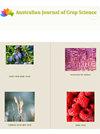含羞草种子物候特征及生理品质研究。
Q3 Agricultural and Biological Sciences
引用次数: 0
摘要
在水资源条件有限的地区生产森林物种仍然是一个需要克服的挑战。因此,开展水分胁迫对植物生长发育和繁殖能力影响的研究是十分必要和迫切的。有鉴于此,本研究旨在探讨降雨脉冲对含羞草(Mimosa caesalpiniifolia Benth)种子繁殖物候期、产量和活力的影响。在田间选定的植物中记录了两周的开花和结果物候期,然后将这些观测结果与该地区的气候数据进行了关联。生理电位的评价已经通过从物候期研究的树木上收获的5批种子的发芽试验进行了。一般来说,观察到sabi本文章由计算机程序翻译,如有差异,请以英文原文为准。
Phenological aspects and physiological quality of seeds of Mimosa caesalpiniifolia Benth.
Producing forest species in regions with limiting water conditions is still a challenge to be overcome. Thus, it is necessary and urgent to develop research that measure the influence of water stress on the growth, development and propagation capacity of species. Given the above, the objective of this work was to determine the influence of rainfall pulses on reproductive phenophases, production and vigor of seeds of Mimosa caesalpiniifolia Benth. Biweekly flowering and fruiting phenophases were recorded in selected plants in the field, and later these observations were correlated with climatic data from the region. Already the evaluation of the physiological potential was carried out through a germination test in five lots of seeds harvested from the trees of the phenophases study. Generally, it was observed that the sabiá (M. caesalpiniifolia) produced seeds between the first half of April and the second half of June, and in the second half of August and the first half of September 2021. The reproductive phenology of the sabiá depends on the extension and frequency of rainfall pulses. The pulse extension was favorable to the physiological potential of the seeds as the germination ranged from 85 to 96%. Therefore, M. caesalpiniifolia has its phenology and productive potential influenced by precipitation pulses.
求助全文
通过发布文献求助,成功后即可免费获取论文全文。
去求助
来源期刊

Australian Journal of Crop Science
农林科学-农艺学
CiteScore
1.20
自引率
0.00%
发文量
75
审稿时长
3.5 months
期刊介绍:
Information not localized
 求助内容:
求助内容: 应助结果提醒方式:
应助结果提醒方式:


